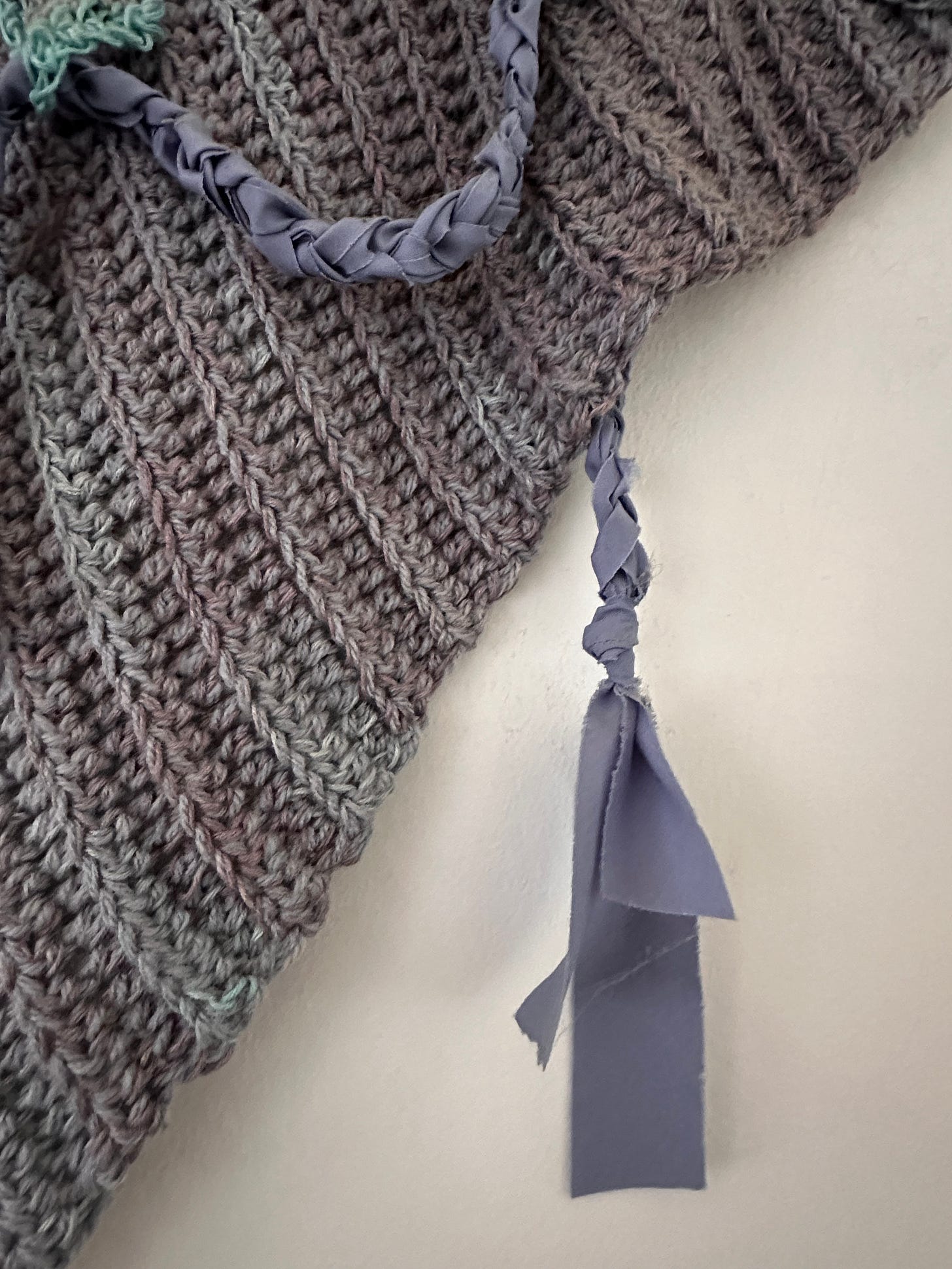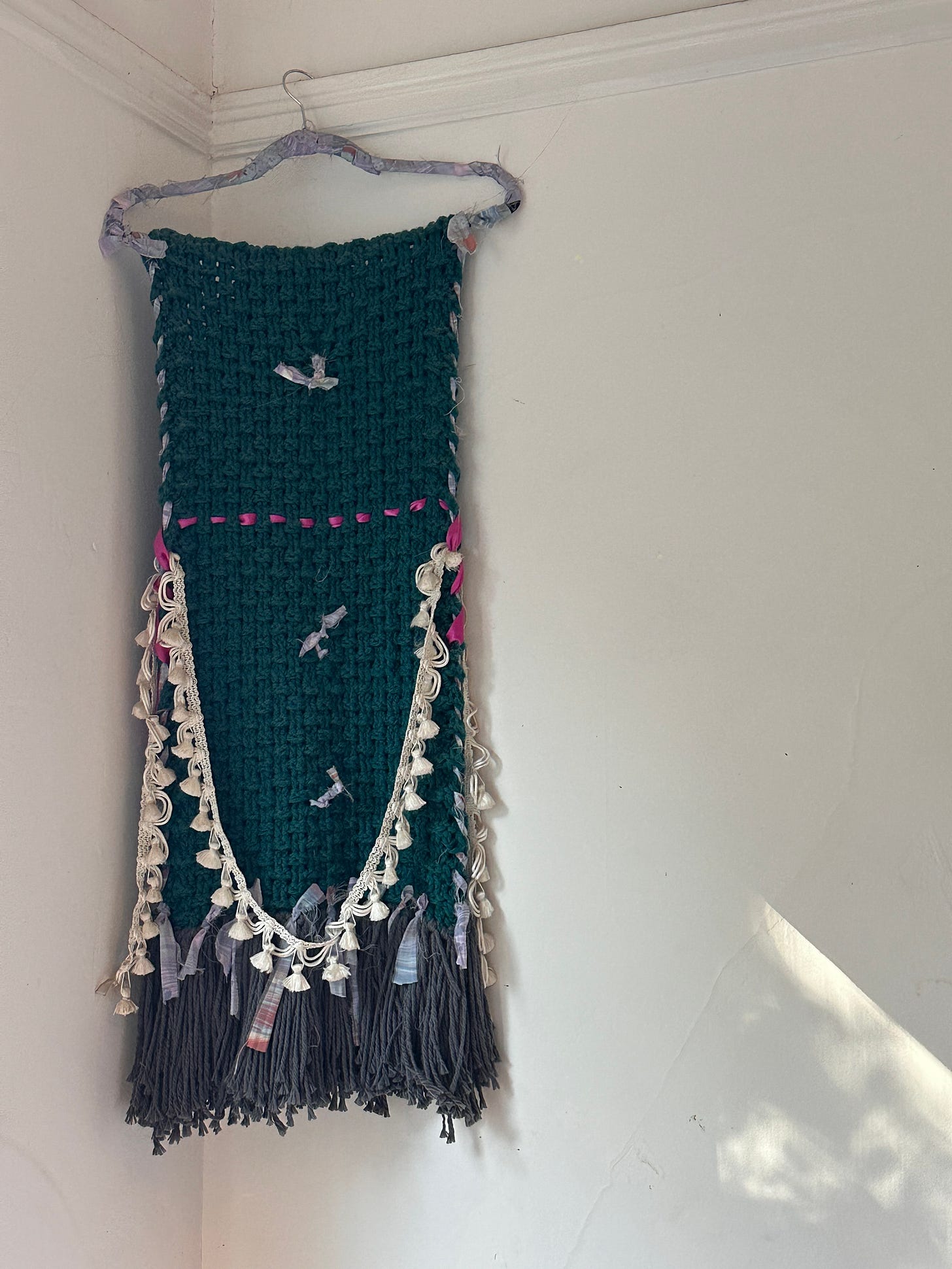Domestic Magic 1: The Story Behind the Crochet Art Piece
Learn about this piece, the full series, and how I'm presenting it, in words, for professional submissions
This is one of my favorite crochet art pieces that I have ever created. I made it a few years back and recently, I have been submitting it to open calls, which means that I’ve had to title it and think about how to describe it. While doing that, I thought it might be interesting to some of you to learn the story behind this piece and what it means to me. I’ve been calling the series, Domestic Magic, and I’ve just numbered the pieces in it so this is Domestic Magic 1.
Here’s how I’ve been phrasing it for professional submissions:
Domestic Magic 1 is part of a larger series, Domestic Magic, which explores the intersection of home, tradition, craft, and identity. Through these works, I challenge the boundary between art and craft, highlighting the ways in which fiber arts—long associated with domestic labor and undervalued as “women’s work”—carry deep personal and cultural significance.
Domestic Magic 1 is a textile-based wall hanging in which an unfinished crochet piece has been shaped into a garment—a shawl that cannot be worn. Layers of woven and braided materials are integrated, creating a complex and layered visual narrative. The piece is suspended on a fabric-wrapped hanger, a reference to the vintage crochet-covered hangers of the early 20th century, which were once common handmade objects in the home.
This work is about domesticity and preservation, but also about transformation—about the way fiber, function, and meaning shift over time. It is about the ways we care for things, the things we discard, and the things we repurpose into something entirely new.
The History of Fabric-Covered Coat Hangers
I decided to hang these pieces on old coat hangers, which I’ve wrapped with fabric. Back when I did a lot of crochet blogging, I immersed myself in crochet history and I created roundups of all different kinds of crochet patterns. Along the way, I came across crochet-covered coat hanger patterns and learned some of the history behind them. I always think of them as a 1950’s era household thing but there’s more to them that.
Origins and Evolution
Coat hangers became common household objects in the late 19th and early 20th centuries, following the rise of mass-produced clothing. As wardrobes expanded, so did the need for better garment storage. Wire hangers, introduced in the early 1900s, were functional but prone to creasing delicate fabrics. Wooden hangers provided more structure but lacked grip, allowing garments to slip off.
Enter the handcrafted crochet-covered hanger—a simple but ingenious solution. By wrapping hangers in crochet, fabric, or ribbon, crafters transformed them into protective, decorative objects. The soft, textured surface kept clothing in place, while the added padding prevented sharp hanger marks on delicate materials like silk and wool.
By the 1930s and 1940s, as women’s magazines and crafting booklets promoted DIY home projects, crochet-covered hangers became a symbol of homemaking skill. They were often part of bridal trousseaus, lovingly made by mothers and grandmothers to prepare a young woman for married life. These handcrafted hangers signified care, attention to detail, and a sense of pride in domestic labor.
The choice to hang Domestic Magic 1 on a fabric-wrapped hanger reinforces themes of domesticity, preservation, and care. Hangers, as tools meant to maintain and protect clothing, are much like crochet itself - used to provide warmth and comfort. But here, the piece is suspended, frozen in time—a moment of labor captured and displayed as art.
The Gendered Nature of Domestic Craft
There is, of course, a long history of debating about art vs. craft, with craft (often historically meaning what women create with their hands) not being taken seriously in the way that fine art has been, although in my personal experience this has shifted in the 21st century, at least to some degree.
Despite their aesthetic and functional value, crochet-covered hangers—like many forms of fiber art—were rarely acknowledged as significant artistic expressions. Instead, they were categorized as craft, a term often used to diminish the work of women in the domestic sphere. The artistry involved in creating these hangers—choosing colors, perfecting stitches, sometimes incorporating intricate lace patterns—was dismissed as “women’s work,” overshadowed by the male-dominated fine arts world.
Even as mass production replaced handmade household goods in the mid-to-late 20th century, the tradition of crochet-covered hangers persisted, often as acts of love and nostalgia rather than necessity. Many people still cherish hangers crocheted by grandmothers decades ago, each one carrying the weight of memory and the invisible labor of care.
By incorporating the fabric-wrapped hanger into Domestic Magic 1, I am reclaiming this tradition, bringing it into the realm of fine art rather than allowing it to be dismissed as mere domestic craft.
The Meaning of Domestic Magic 1
All of the pieces in the Domestic Magic series represent the same things but each piece is also unique. Crochet can be a highly personal and expressive medium. It is repetitive and meditative, yet it can also be done in a deeply intentional way.
This particular piece of crochet was shaped into a shawl but then stitched closed, making it unwearable. It is a deliberate statement—a rejection of function in favor of concept. It challenges the notion that crochet must be useful to be valuable, pushing against the historical dismissal of fiber arts as secondary to painting, sculpture, and other fine arts.
Transformation: Unfinished Garments as Art
In this piece, I take crochet items that I’ve started and not completed, and I transform them into completed works of art. Often, in periods of depression or stress, I crochet large squares and rectangles solely for the healing process of making them, of the tactile and visual experience. Sometimes, these become blankets or scarves or I stitch them into wearable clothing. Sometimes, they just become “scraps”.
Sometimes, we abandon projects. Maybe we make mistakes. Maybe our emotions change, and we no longer feel connected to the piece. Maybe life simply interrupts the process. Traditionally, an unfinished garment might be seen as a failure—something incomplete, something wasted.
But what if, instead of discarding it, we transform it into something new?
That is part of the ethos behind Domestic Magic 1. By taking an unfinished garment and repurposing it into an art piece, I embrace the idea that crochet (and life) does not always have to be linear. A project does not have to be completed to be meaningful. The flaws, the unfinished edges, the “mistakes” all become part of the final work. They are art.
Adding Jewelry: The Tension Between Adornment and Constraint
Incorporating jewelry-like embellishments into this piece adds another layer of meaning. Jewelry, historically a marker of status and beauty, becomes entangled in the fabric, woven into something no longer wearable. The piece is adorned, yet restricted. The contrast between ornamentation and limitation speaks to the experiences of women throughout history—expected to be beautiful yet constrained by societal roles, decorated yet undervalued.
The Colors: A Story of Depression, Healing, and Art
The colors in Domestic Magic 1—blues and greys—carry deep personal meaning for me. They represent my own journey with depression, creativity, and crafting to heal. As I’ve shared in other places, including my book Crochet Saved My Life, depression once made dulled the colors of my world and crochet helped to bring it back. Here’s an excerpt from that book:
One of the key images that has stuck with me as I’ve researched the health benefits of crochet is an image laid out by Margaret Mills in her article titled The Healing Arts and Crafts, in which she said: “As the rhythmic work, the feel of yarn, and the misshapen poncho taking shape under my hands turned the world from black and white to Technicolor, I realized that I was also dealing with a bout of depression. I’ve since resumed my long-neglected sewing as well, and the world is a brighter place. Making handcrafted items lifts my spirits and boosts my energy.”
I think what struck me about this image is the idea that your world is black and white (or merely grey!) and that crochet can bring color back into it. That was certainly the case for me. I saw grey everywhere I turned until I didn’t want to bother turning anymore. Crochet reminded me of the simple beauty of color. Not that I started drastically introducing color into my life. In fact, the very first ball of yarn that I picked out when learning how to crochet was a grey ball! Go figure. But I added a beautiful teal color to it that I thought went well with it and thus my exploration of color began. I didn’t consciously understand the healing power of color but something inside of me yearned to infuse my life with color to erase the grayness of emotion that pervaded every corner of my days.
And eventually, it wasn’t just in the comfort of my crochet corner that color blossomed. I began to notice color in other places again. I noticed the tone of a friend’s skin color because I wanted to make her a scarf and wanted to choose colors that would flatter her. I noticed the colors in the skirt of a passerby because I liked the pattern and wanted to create something similar. Before I knew it I was noticing the blue in the sky, the blue in my boyfriend’s eyes, in a way that I simply hadn’t noticed in a very, very long time. I saw color again because I’d been working with color in my hands for so many months. Depression takes things away without asking your permission. I hadn’t realized that my sense of sight had become so limited to a grey world until color returned.
Talking About Art
As I try to wrap this piece up, I’m reminded of the Playing By Heart quote “talking about love is like dancing about architecture.” Sometimes it feels so futile to describe art because the words box it in and make it something specific that’s not quite the thing itself. But in order to share the work with others - online and generally but specifically for submission in professional settings - I have had to put words to it. One of the things I’ve included in some of that writing is this:
Through Domestic Magic 1, I embrace crochet as an art form in its own right, weaving together threads of history, identity, and emotion. In a world that often overlooks both craft and the experiences of women, this piece serves as a quiet yet powerful statement:
Domestic labor is art, and art is magic.
THREADSTACK is a free newsletter but it does take work so if you’re able to support it with a paid subscription, it truly means a lot.






Love this, so inspirational and thoughtful.